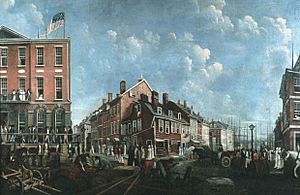Buttonwood Agreement facts for kids
The Buttonwood Agreement is a very important paper that helped create what we now call the New York Stock Exchange (NYSE). The NYSE is a famous place where people buy and sell parts of companies, called stocks. This agreement helped organize how stocks were traded in New York City.
It was signed on May 17, 1792, by 24 stockbrokers. Stockbrokers are people who help others buy and sell stocks. They signed the agreement outside a building on Wall Street. Some people say they signed it under a big tree called a buttonwood tree. That's why it's called the Buttonwood Agreement! Even if the tree wasn't really there, the NYSE still celebrates this day as its birthday.
How the Agreement Started
After signing the agreement in 1792, the brokers soon moved their business indoors. By 1793, they were meeting and trading inside the Tontine Coffee House. This was a popular spot where people gathered for news and business.
A famous news magazine from London, The Economist, even named one of its financial columns after this agreement. This shows how important the Buttonwood Agreement is in financial history. Today, the original document is kept safe in the archives of the New York Stock Exchange.
What the Agreement Said
The Buttonwood Agreement was quite simple, but it changed how stocks were traded. It had two main rules:
- The brokers agreed to only trade with each other. This meant they would not use other people, like auctioneers, to buy or sell stocks.
- They also agreed on a set fee for their services. They would charge a commission of 0.25% for every trade. This means for every $100 traded, they would get 25 cents.
Here is what the agreement said:
We the Subscribers, Brokers for the Purchase and Sale of the Public Stock, do hereby solemnly promise and pledge ourselves to each other, that we will not buy or sell from this day for any person whatsoever, any kind of Public Stock, at a less rate than one quarter percent Commission on the Specie value and that we will give preference to each other in our Negotiations. In Testimony whereof we have set our hands this 17th day of May at New York, 1792.
The Signers
The 24 brokers who signed the Buttonwood Agreement are sometimes called the Founding Fathers of the New York Stock Exchange. They were:
- Peter Anspach … 3 Great Dock Street
- Armstrong & Barnewall … 58 Broad Street
- Andrew D. Barclay … 136 Pearl Street
- Samuel Beebe … 21 Nassau Street
- G. N. Bleecker … 21 Broad Street
- Leonard Bleecker … 16 Wall Street
- John Bush … 195 Water Street
- John Ferrers … 205 Water Street
- Isaac M. Gomez … 32 Maiden Lane
- Travis Handak … 55 Broad Street
- John A. Hardenbrook … 24 Nassau Street
- Ephraim Hart … 74 Broadway
- John Henry … 13 Duke Street
- Augustine H. Lawrence … 132 Water Street
- Samuel March … 243 Queen Street
- Charles McEvers Jr. … 194 Water Street
- Julian McEvers … 140 Greenwich Street
- David Reedy … 58 Wall Street
- Robinson & Hartshorne … 198 Queen Street
- Benjamin Seixas … 8 Hanover Square
- Hugh Smith … Tontine Coffee House
- Sutton & Hardy … 20 Wall Street
- Benjamin Winthrop … 2 Great Dock Street
- Alexander Zuntz … 97 Broad Street



